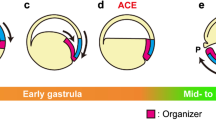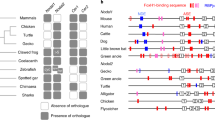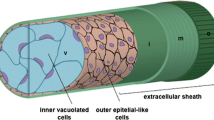Abstract
The internal organs of vertebrates show species-specific left-right (L-R) asymmetries. Questions on the embryonic origin of these asymmetries have been fascinating embryologists since the 19th century. During the past years, remarkable progress has been made in answering these questions. Evolutionary highly conserved molecular signaling cascades have been identified that start from Hensen’s node and transfer side-specific identity to the embryonic left and right halves. However, the question of what initiates these signaling cascades has remained unanswered. Studies on mouse embryos have shown that the ventral surface of Hensen’s node consists of a ciliated epithelium called the ventral node. Recent findings suggest that the monocilia of ventral nodel cells generate a leftward flow of extracellular fluid possibly leading to the accumulation of an unknown morphogen at the left of the node, which then might start the signaling cascades. This hypothesis might explain the fact that gene defects causing ciliary dyskinesia are frequently associated with situs anomalies. Studies on chick embryos led to the discovery of the L-R signaling cascades. However, whether an equivalent of the ventral node exists in avian embryos remained unknown. Therefore, I examined the endoderm and epiblast of early chick embryos for the presence of monociliated cells. In the endoderm, a population of monociliated cells indeed was present. These cells, however, were neither confined to the area of Hensen’s node nor did they form the predominant cell population at this location. In the epiblast, monociliated cells formed the predominant cell population at the periphery of the blastodisc but only a relatively small subpopulation of epiblast cells at Hensen’s node. These findings suggest that, in the early chick embryo, an equivalent of the ventral node of mouse embryos neither exists on the ventral nor the dorsal surface of Hensen’s node. It is unlikely that nodal cilia are required for initiating the L-R patterning in chick embryos.
Similar content being viewed by others
Author information
Authors and Affiliations
Additional information
Accepted: 8 March 2001
Rights and permissions
About this article
Cite this article
Männer, J. Does an equivalent of the ”ventral node” exist in chick embryos? A scanning electron microscopic study. Anat Embryol 203, 481–490 (2001). https://doi.org/10.1007/s004290100183
Issue Date:
DOI: https://doi.org/10.1007/s004290100183




